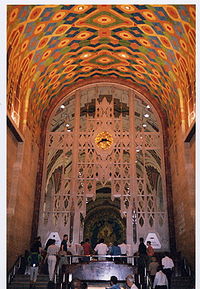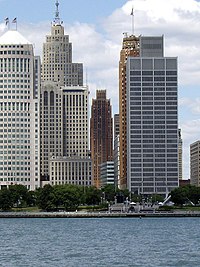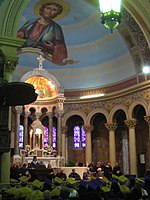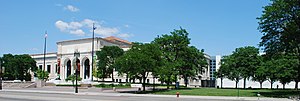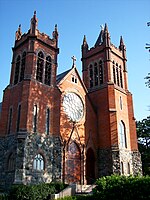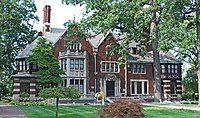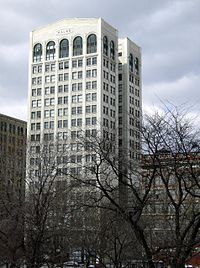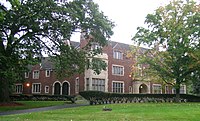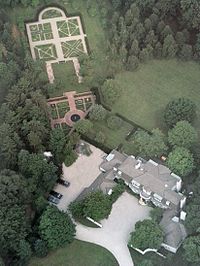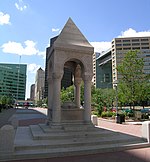Architecture of metropolitan Detroit
[5][6] In the 1880s, Gilded Age architects such as Wilson Eyre[7] Gordon Lloyd, Harry J. Rill, Henry T Brush, Julius Hess, John V Smith, Elijah E Myers, Alamon C Varney, Mortimer L Smith, Peter Dederich, Joseph e MiIls and the firms Donaldson & Meier, Malcomson & Higginbotham and Mason & Rice who had designed churches and residences in the most exclusives neighborhoods (Woodward Avenue, Brush Park, Jefferson Avenue and W Fort Street), turned their attention to office and commercial buildings.
[3] Daniel Burnham, Louis Kamper, and the Smith Hinchman & Grylls firm are among the architects who designed some of the city's other important skyscrapers at the turn of the century which endure today.
Joseph L. Hudson, the department store magnate, had commissioned architect Hugh Ferriss to produce a series of renderings depicting new buildings for the city skyline.
[15] Hudson's Department Store window displayed the Ferriss drawings to commemorate its fiftieth anniversary, and to celebrate the opening in 1927 of a new building for the Detroit Institute of Arts, a Beaux-Arts, Italian Renaissance-styled structure.
Architect Wirt C. Rowland played an integral role in crafting the city's historic skyline with his designs for the Buhl, Penobscot, and Guardian buildings.
Architectural tiles made from Pewabic Pottery by American ceramist Mary Chase Perry Stratton are a prominent feature in the Guardian Building's facade and decor.
One Detroit Center (1993) and its neogothic spires is considered a fine example of post modern architecture by architects Philip Johnson and John Burgee, referring to Wirt Rowland's historic Penobscot Building (1928), both located in the heart of the Financial District's wireless Internet zone.
In the ensuing decades, the Renaissance Center expanded to join the city's restored historic art deco skyscrapers in forming the current skyline.
[38] Quicken Loans purchased office buildings in downtown Detroit and has considered new sites for new construction at the former Statler on Grand Circus Park and the former Hudson's location.
In 2009, DTE unveiled a $50 million transformation of the landscape around its downtown headquarters into an urban oasis with parks, walkways, and a reflecting pool adjacent to the MGM Grand Detroit.
Other historic restoration projects in Detroit include developments in the Midtown area, the Doubletree Guest Suites Fort Shelby, and the Westin Book-Cadillac Hotel.
Architect Anthony Caradonna designed the Cadillac Centre concept in the postmodern architectural genre known as deconstructivism similar to the Guggenheim Museum Bilbao.
[6] The Gothic styled St. Joseph Church (1873/1883) in the Eastern Market-Lafayette Park neighborhood by Francis G. Himpler is an authentic German Catholic Parish and an important site listed in the National Register of Historic Places, noted for its architecture and stained glass.
[6] The Gothic Revival cathedral styled Sweetest Heart of Mary (1893) in the Forest Park neighborhood area by Spier and Rohns is the largest Roman Catholic Church in Detroit.
The large concentration of Poles in the metropolitan Detroit resulted in a number of ornate churches in the Polish Cathedral style designed by noted architects.
Compuware World Headquarters overlooks the reconstructed traffic circle surrounding Campus Martius Park with the historic Michigan Soldiers' and Sailors' Monument of the American Civil War by Randolph Rogers.
Shortly afterward, Father Gabriel Richard said, Speramus meliora; resurget cineribus, meaning, We hope for better things; it will arise from the ashes, which became the city's official motto.
In Gothic revival design, St. John's Episcopal Church (1861) stands across from the Fox Theatre and beside Comerica Park along with Woodward Avenue's vintage street lights.
Topped with bronze quadrigas by J. Massey Rhind and an Anthony Wayne pediment by Edward Wagner, it may be America's finest surviving example of Roman Baroque architecture with a blend of Beaux-Arts.
Cret was also the architect of the Folger Shakespeare Library in Washington, D.C. Michael Graves designed the 2007 renovation and expansion of the Detroit Institute of Arts with its exterior covered in white marble.
Harley, Ellington and Day designed the marble Neoclassical Horace Rackham Education Memorial Building (1941) also within the Cultural Center Historic District.
[6] Eliel's son, the famed modernist Eero Saarinen, designed a complex of buildings in the suburb of Warren, Michigan for General Motors known as the GM Technical Center.
The Southwest is seeing redevelopment and construction of new homes and condos due in part to the city's expanding Mexicantown area surrounding Clark Park, which is near the architecturally significant Most Holy Redeemer Church and Ste.
The West Canfield, Woodbridge, and East Ferry Avenue neighborhoods are examples of Midtown's restored French Renaissance Revival, Second Empire, Romanesque, and Queen Anne architecture.
It features elaborate stone carvings and intricate ironwork and was the subject of a 1926 "Fortune Magazine" discussion of "the harmony of materials and proportion in residential architecture."
[62] Many architecturally distinctive homes are also located near the University of Detroit Mercy on the city's North end such as those in Palmer Woods and Sherwood Forest historic districts.
Detroit's heritage includes works by Frank Lloyd Wright who had participated in the initial design for Henry Ford's Fair Lane Estate,[68] a National Historic Landmark in Dearborn.
Designed by Horace Trumbauer as a Louis XV styled château, Rose Terrace was an enlarged version of the firm's Miramar in Newport, Rhode Island.
The Italian Renaissance styled Russell A. Alger Jr. House (1910), at 32 Lakeshore Dr., by architect Charles A. Platt serves as the Grosse Pointe War Memorial.
[72] The five Grosse Pointe communities feature a variety of newer and early-twentieth-century mansions which flank the shores of Lake St. Clair, one of the finest examples being Woodley Green (the Benson Ford House, 1934) by Hugh T. Keyes (considered "one of the most prolific and versatile architects of the period").


